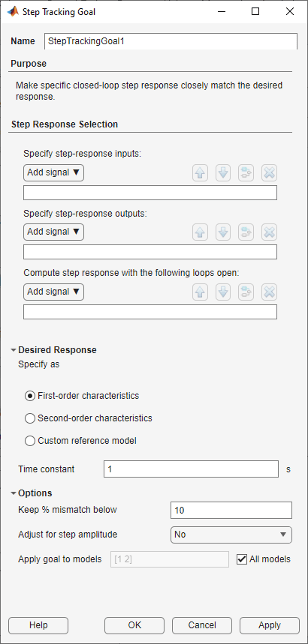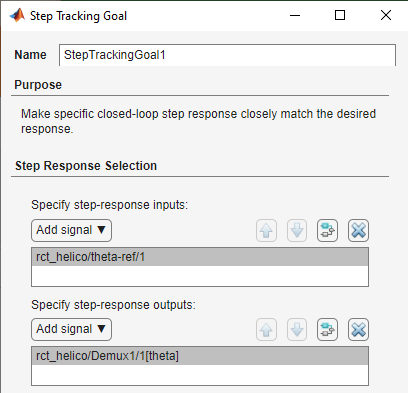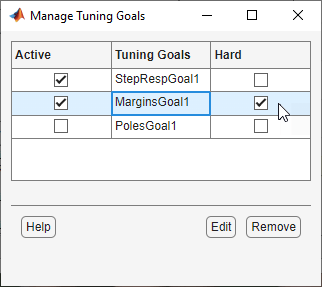Specify Goals for Interactive Tuning
This example shows how to specify your tuning goals for automated tuning in Control System Tuner.
Use the New Goal menu to create a tuning goal such as a tracking requirement, disturbance rejection specification, or minimum stability margins. Then, when you are ready to tune your control system, use Manage Goals to designate which goals to enforce.
This example creates tuning goals for tuning the sample model
rct_helico. For an example that tunes this controller, see Tune a Control System Using Control System Tuner.
Choose Tuning Goal Type
In Control System Tuner, in the Tuning tab, click
![]() New Goal. Select the type of goal you want to create. A tuning goal
dialog box opens in which you can provide the detailed specifications of your goal. For
example, select Tracking of step commands to make a particular
step response of your control system match a desired response.
New Goal. Select the type of goal you want to create. A tuning goal
dialog box opens in which you can provide the detailed specifications of your goal. For
example, select Tracking of step commands to make a particular
step response of your control system match a desired response.

Choose Signal Locations for Evaluating Tuning Goal
Specify the signal locations in your control system at which the tuning goal is evaluated. For example, the step response goal specifies that a step signal applied at a particular input location yields a desired response at a particular output location. Use the Step Response Selection section of the dialog box to specify these input and output locations. (Other tuning goal types, such as loop-shape or stability margins, require you to specify only one location for evaluation. The procedure for specifying the location is the same as illustrated here.)
Under Specify step-response inputs, click
![]() Add signal to list. A list of available input locations appears.
Add signal to list. A list of available input locations appears.
If the signal you want to designate as a step-response input is in the list, click the signal to add it to the step-response inputs. If the signal you want to designate does not appear, and you are tuning a Simulink® model, click Select signal from model.

In the Select signals dialog box, build a list of the signals you want. To do so, click signals in the Simulink model editor. The signals that you click appear in the Select signals dialog box. Click one signal to create a SISO tuning goal, and click multiple signals to create a MIMO tuning goal.
Click Add signal(s). The Select signals dialog box closes, returning you to the new tuning-goal specification dialog box.

The signals you selected now appear in the list of step-response inputs in the tuning goal dialog box.
Similarly, specify the locations at which the step response is measured to the
step-response outputs list. For example, the following configuration constrains the
response to a step input applied at theta-ref and measured at
theta in the Simulink model rct_helico.

Tip
To highlight any selected signal in the Simulink model, click ![]() . To remove a signal from the input or output list,
click
. To remove a signal from the input or output list,
click ![]() . When you have selected multiple signals, you can
reorder them using
. When you have selected multiple signals, you can
reorder them using ![]() and
and ![]() .
.
Specify Loop Openings
Most tuning goals can be enforced with loops open at one or more locations in the
control system. Click ![]() Add loop opening location to list to
specify such locations for the tuning goal.
Add loop opening location to list to
specify such locations for the tuning goal.
Define Other Specifications of the Tuning Goal
The tuning goal dialog box prompts you to specify other details about the tuning goal. For example, to create a step response requirement, you provide details of the desired step response in the Desired Response area of the Step Response Goal dialog box. Some tuning goals have additional options in an Options section of the dialog box.
For information about the fields for specifying a particular tuning goal, click ![]() in the tuning goal dialog box.
in the tuning goal dialog box.
Store the Tuning Goal for Tuning
When you have finished specifying the tuning goal, click OK in the tuning goal dialog box. The new tuning goal appears in the Tuning Goals section of the Data Browser. A new figure opens displaying a graphical representation of the tuning goal. When you tune your control system, you can refer to this figure to evaluate graphically how closely the tuned system satisfies the tuning goal.

Tip
To edit the specifications of the tuning goal, double-click the tuning goal in the Data Browser.
Activate the Tuning Goal for Tuning
When you have saved your tuning goal, click ![]() New Goal to create additional tuning goals.
New Goal to create additional tuning goals.
When you are ready to tune your control system, click ![]() Manage Goals to select which tuning goals are active for tuning. In
the Manage Tuning Goals dialog box, Active is
checked by default for any new goals. Clear Active for any tuning
goal that you do not want enforced.
Manage Goals to select which tuning goals are active for tuning. In
the Manage Tuning Goals dialog box, Active is
checked by default for any new goals. Clear Active for any tuning
goal that you do not want enforced.
You can also designate one or more tuning goals as Hard goals. Control System Tuner attempts to satisfy hard requirements, and comes as close as possible to satisfying remaining (soft) requirements subject to the hard constraints. By default, new goals are designated soft goals. Check Hard for any goal to designate it a hard goal.
For example, if you tune with the following configuration, Control System
Tuner optimizes StepRespGoal1, subject to
MarginsGoal1. The tuning goal PolesGoal1 is
ignored.

Deactivating tuning goals or designating some goals as soft requirements can be useful when investigating the tradeoffs between different tuning requirements. For example, if you do not obtain satisfactory performance with all your tuning goals active and hard, you might try another design in which less crucial goals are designated as soft or deactivated entirely.